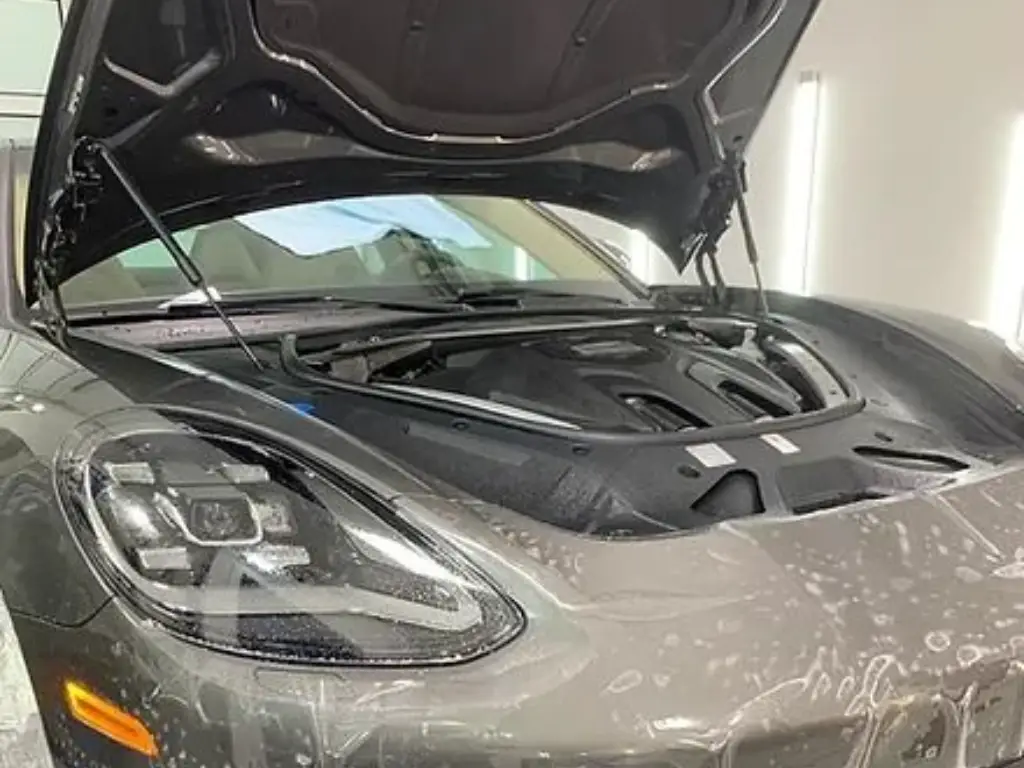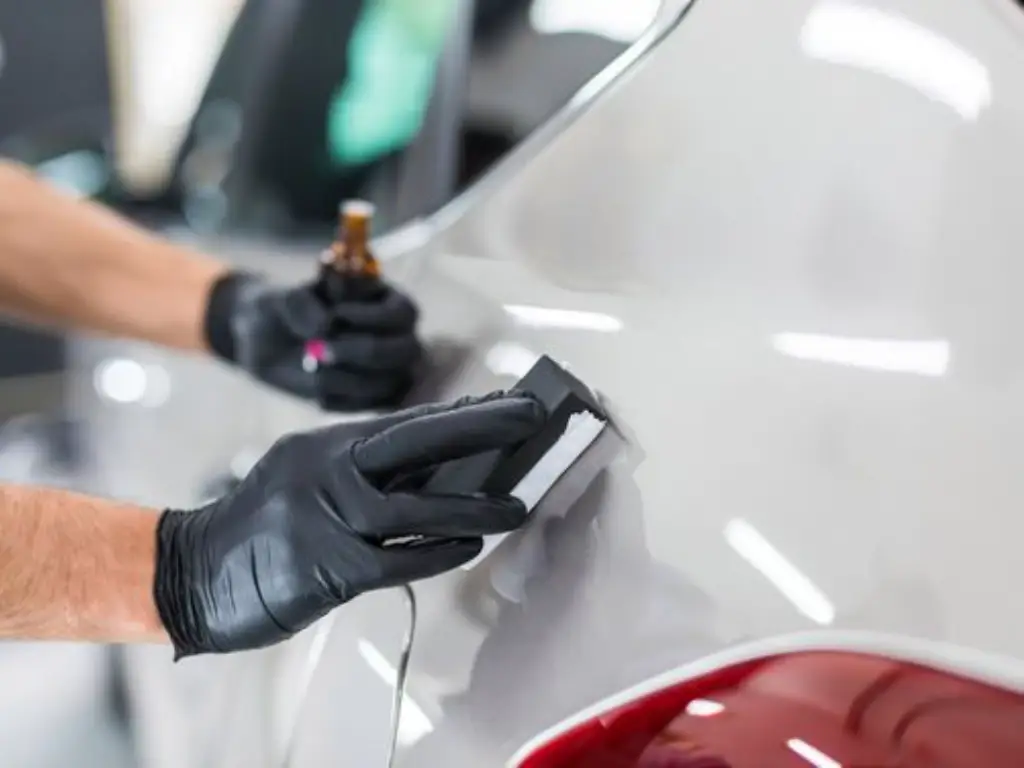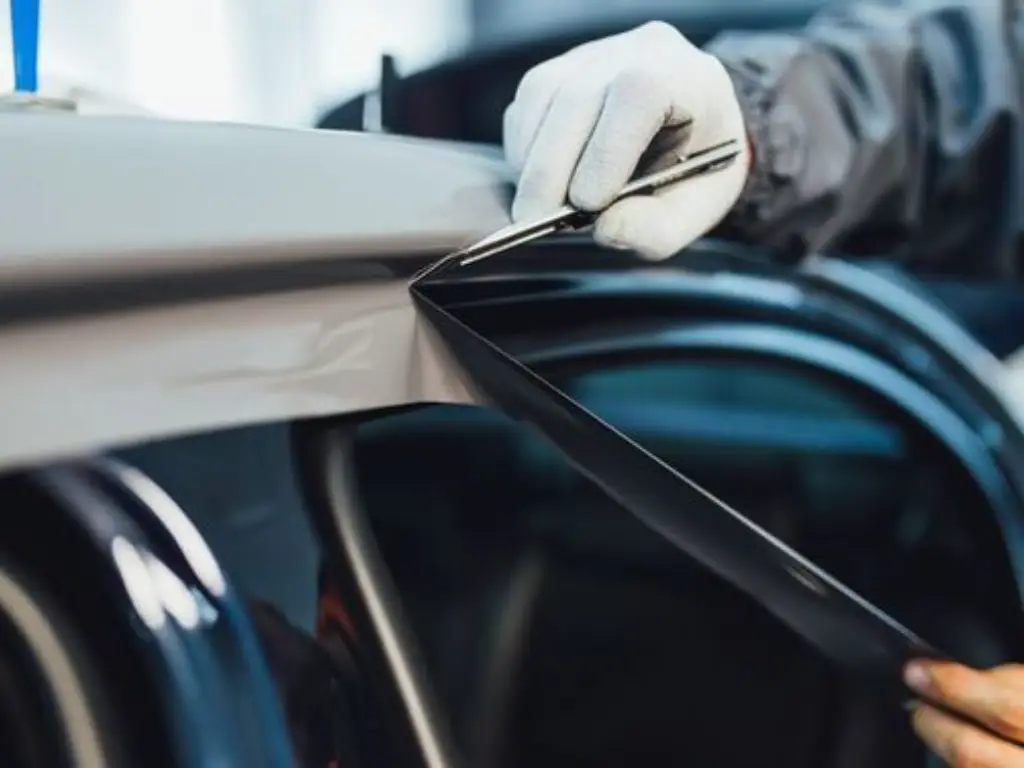Paint protection film, or PPF, is becoming more and more common among both regular drivers and auto enthusiasts. The desire to preserve brand-new cars while shielding the paint job from the abrasive realities of regular driving is what’s causing this spike in demand. We’ll explore the many benefits and drawbacks of paint protection film in this in-depth analysis, giving you insights gleaned from actual experiences and market statistics.
About Paint Protection Film
PPF, also referred to as a clear bra or clear mask, is a thermoplastic urethane film that is transparent and intended to protect a car’s paint job from different types of damage. I have used and analyzed PPF extensively, so I can state with certainty that it’s a good approach to maintain a car’s original appearance.
PPF covers the vehicle’s painted surfaces to create a strong, imperceptible shield. Impacts from rock chips, light scratches, and other physical material that may otherwise harm the paint are absorbed by this protective layer. Because to the sturdy composition of the film, even large impacts are deflected, preserving the underlying paint. Furthermore, PPF provides superior UV protection, preventing paint fading or degradation from extended sun exposure.
Current PPF has hydrophobic properties as well. These characteristics deter water and stop the formation of water spots. The car is therefore simpler to maintain and clean. It is less probable for dirt and grime to adhere to the surface.
Additionally, sophisticated PPF materials are capable of self-healing. Heat from the sun or a heat gun can remove small scratches and swirl marks. The film remains crisp and unobtrusive because to its self-healing function. It offers continuous and superior protection while assisting in maintaining the vehicle’s appearance.
Before we dive into the many advantages of PPF, it’s important to also consider some challenges and potential drawbacks. These aren’t necessarily major issues, but they are points that some car owners find debatable. Let’s explore these aspects first to give you a balanced view.

Disadvantages of Paint Protection Film
1. High Initial Cost
It’s the amount of money spent to set up paint protection film at the beginning which is much that many people worry about. Based on the size of your car and quality of the film, the cost of paint protection film can range from $500 to over $5,000. Several factors influence PPF pricing, including the type and quality of the film, the size and complexity of your vehicle, and the installer’s reputation and experience. To paint an entire luxury vehicle with PPF, for example, this might cost you more than $6,000. Moreover, if one cannot invest huge amounts right away then this upfront cost alone may be prohibitive.
Nevertheless, future savings in painting repairs and maintenance must be accounted for. Depending on how extensive the damage is and what kind of car it affects such regular paint jobs can cost from $1,000 to $5,000. Thus a person willing to keep their car for some years can save money in long run through investing into PPF because they will not require painting it repeatedly. This way despite having high initial costs we can say that there are several reasons why it is actually worth its while
2. Need for Professional Installation
The requirement for skilled installation of automotive paint protection film presents one of the difficulties. The method of appropriately applying PPF is rather complex, even if you could obtain DIY kits. Make sure there are no apparent edges, wrinkles, or bubbles for it to be perfect. The knowledge and expertise of a professional installer guarantees a flawless application and excellent film appearance.
It might be a little difficult to locate a qualified installation when you need one. Selecting a person with a solid track record of PPF installation is crucial. An inadequate installation effort might detract from the movie’s appearance and efficacy. To receive the greatest results and guarantee that your automobile appears as nice as possible with its new protective coating, it is imperative that you take the time to choose a respected specialist.
3. Maintenance and Care Requirements
Maintaining paint protection film needs specific care to keep it working well and looking good. Even though PPF is durable, it can still get scratched or damaged if not looked after properly. Car owners need to use certain cleaning products and methods to avoid damaging the film.
Routine care includes regular washing and sometimes applying a special sealant to keep its water-repelling properties. This extra step can feel like more work compared to regular paint, which might only need washing and waxing. However, this effort is important for making sure the film lasts a long time and keeps the car looking great. For some people, this extra maintenance might seem like a downside, but it’s necessary to keep the PPF providing the strong protection it’s known for.
4. Limited Lifespan
The service life of the paint protection film (PPF) is usually five to ten years depending on the quality and conditions it faces. The film can become discolored, scratched or damaged over time. In such cases, one has to install new PPF.
Replacing PPF involves removing the old film and putting on a new one. This might be almost as costly as the first installation. For instance, replacing a 7-year-high-quality PPF that costs $3,000 may mean spending a similar amount again for a car owner. In case someone wants to do this just once with no further cost, it may not be so good.
However, there are ways of reducing these expenses. Some PPF manufacturers have provided PPF that can last more than 10 years from now. By picking such better films, one would not replace them often thus making the investment worthier at long last.

Advantages of Paint Protection Film
1. Protection Against Scratches and Chips
Paint protection film has a strong advantage of protecting vehicle’s paint from scratches and small dents. I have first-handedly witnessed how much PPF can be when I drive most times on gravel roads. It is an absorbent bed for tiny stone chips and dust that would otherwise damage or chip your car’s paint. The data coming from the industry states that cars equipped with PPF undergo 90% less chipping than those without it.
Especially for high-end vehicles, this safeguard becomes essential since even minor damage to their paintworks can result in depreciation. This over time will go a long way in helping motorists avoid expensive painting services such as paint corrections and touch-ups so definitely, spending the initial installation price of PPF is a wise long term decision.
2. UV Radiation and Corrosion Resistance
Paint protective film has a great ability to resist UV radiation and corrosion. For example, in the case of a vehicle’s painting that may deteriorate with time due to fading because of UV rays, PPF would not allow these destructive beams thus appearance of color and shine will remain constant. For instance, research demonstrated that automobiles bearing PPF had an original look 30% longer than those without it.
In addition, PPF is a kind of barrier against corroding agents such as bird dropping drops, tree exudates or road salts corrosive substances. In case these pollutants are left unattended for long they can remove clear coat and the paint as well. Such risk is highly mitigated by PPF hence ensuring that the exterior remains clean for a long period before any degradation takes place.
3. Self-Healing Properties
To distinguish them from others, modern paint protection films are designed with self-healing properties. Once your film has a bruise or an acrobat mark, an increase in temperature will remove it. With this property therefore, the film remains polished and clear, which is quite important to car owners who desire to maintain their cars’ unmarred appearances.
If I recall correctly, there was once when I saw a deep scratch on my car’s PPF caused by a tree branch. The scratch had almost disappeared after leaving the car out in the sun for some hours. This type of healing not only makes the film last longer but also means that the vehicle will look good for a long time without much work put into it.
4. Boosts Its Aesthetic Appeal
While some may argue about how film application can take off a car’s natural splendor, high-quality PPF actually makes the vehicle more aesthetically appealing. The film offers that lustrous look to make paintwork appear more vibrant and polished. For car enthusiasts, this added shine is a bonus that complements the vehicle’s overall look.
When correctly applied to cars, PPF can be virtually invisible hence it maintains the original design and color of the car. This simply means that while benefiting from an extra layer of protection, the car retains its intended outlook. With improved visual appeal and safety features PPF becomes a preferred choice among those who cherish their vehicles’ looks.
5. Customizable Coverage Options
By choosing to install PPF, car owners can protect the areas that are likely to be damaged. For instance, only the front bumper, hood and side mirrors can have PPF or it can cover the whole body panels. This adaptability is ideal for all budgets and protection requirements.
Customizable options imply that you could preferentially safeguard the best parts of your car. An example would be driving mainly around congested cities where the importance is on shielding your vehicle’s front end from bumper-to-bumper traffic damage. In this manner, a bespoke method guarantees that you maximize the benefits of your investment without incurring unnecessary expenses.
6. Extends Vehicle Lifespan
Paint protection film can add years to the useful life of a vehicle’s paint by providing top cover from various harmful elements. This is particularly important for those who plan to keep their vehicles for a long time. A well maintained painted car does not only make the car look good but also helps in its resell value and structural strength, without incurring any additional cost.
For instance, cars installed with PPF have been observed to maintain their factory finishes as well as structural quality for much longer periods compared to those without. As such aging has taken place, less repainting and minor bodywork need to be done on these cars hence giving an opportunity for owners of these cars to save on time and money eventually.
Market Perception of PPF-Equipped Vehicles
Resale value is enhanced on vehicles with paint protection film. When a car’s exterior is well taken care of, the study by Kelley Blue Book claims that it can sell for about 10-15% more than someone else’s vehicle. In cars having PPF, this arises because buyers are ready to pay extra cash to get a car that has been protected from paint damage.
But not all notions are always bright. Some prospective customers may be worried if they notice obvious problems with the PPF application. Bubbles, irregular edges, and discolorations are among these factors that subtract from the attractiveness of the automobile in question. The key thing is quality installation which will ensure that none of these issues arise and that the film is all but invisible. However, most automakers agree that when installed correctly PPF comes with more advantages than disadvantages even though there might be some downsides associated with its use.
Comparing PPF with Other Paint Protection Options
PPF vs. Ceramic Coating
When comparing paint protection film with ceramic coating, it’s essential to understand the unique benefits each offers. Ceramic coatings provide a durable, hydrophobic layer that repels water and dirt, making the car easier to clean. They also offer some protection against minor scratches and UV rays. However, ceramic coatings do not provide the same level of physical protection against rock chips and more severe scratches that PPF does.
For instance, a ceramic-coated vehicle might require touch-ups or additional layers of coating over time, whereas PPF acts as a more robust shield. Many car owners choose to use both PPF and ceramic coating to maximize protection, with PPF covering high-impact areas and ceramic coating applied to the entire vehicle for ease of maintenance and enhanced gloss.
PPF vs. Vinyl Wrap
Vinyl wraps are another popular alternative to car paint protection film. They offer the flexibility to change the color and finish of a vehicle, providing a unique and customized look. However, vinyl wraps are primarily aesthetic and do not offer the same level of protection as PPF. Vinyl is more susceptible to damage from rock chips, scratches, and UV rays compared to the durable, protective properties of PPF.
For example, while a vinyl wrap might enhance a car’s appearance temporarily, it will not prevent the kind of damage that PPF is designed to withstand. Car owners seeking both protection and aesthetic customization often combine vinyl wraps with PPF, applying the film to critical areas to ensure comprehensive protection.
| Feature | Paint Protection Film | Ceramic Coating | Vinyl Wrap |
| Protection Against Scratches | Excellent protection against rock chips and severe scratches | Good for minor scratches | Limited protection against rock chips and scratches |
| UV Radiation Resistance | High, prevents paint fading and degradation | Good, prevents paint fading | Moderate, can fade over time |
| Hydrophobic Properties | High, repels water and prevents water spots | High, repels water and makes cleaning easier | Moderate, varies depending on the wrap quality |
| Self-Healing Properties | Yes, minor scratches and swirl marks heal with heat | No, requires reapplication or touch-ups | No, damages are permanent until rewrapped |
| Aesthetic Appeal | Maintains original color and design, adds gloss | Adds gloss, enhances paint appearance | Changes color and finish, customizable look |
| Maintenance | Regular washing, occasional PPF-safe sealant application | Regular washing, may need reapplication over time | Regular cleaning, rewrap if damaged |
| Durability | 5-10 years depending on quality and conditions | 2-5 years, may need additional layers | 3-5 years, depending on exposure and quality |
| Cost | High initial cost, $500 – $5,000+ | Moderate, varies based on quality | Moderate to high, varies based on design and coverage |
| Installation | Requires professional installation for best results | Professional application recommended | Can be DIY or professionally installed |
Conclusion: Is Paint Protection Film Worth It?
In conclusion, the pros and cons of ppf must be carefully considered by each car owner. While the high initial cost and need for professional installation are significant disadvantages, the benefits of superior protection, enhanced aesthetic appeal, and extended vehicle lifespan make PPF a worthwhile investment for many. This paint protection film review highlights that, despite its drawbacks, PPF, as an invisible shield, offers a level of protection and value that other options simply cannot match.
Ultimately, whether PPF is worth it depends on individual priorities and the specific needs of the vehicle. For those who value long-term preservation of their car’s appearance and are willing to invest in professional-grade protection, paint protection film stands out as an excellent choice.
